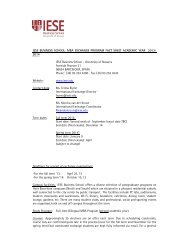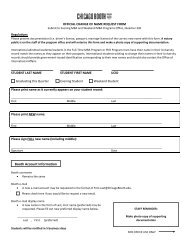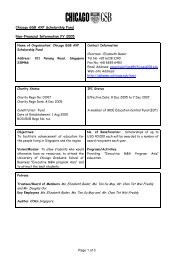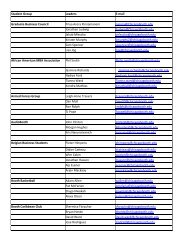P - Chicago Booth Portal
P - Chicago Booth Portal
P - Chicago Booth Portal
You also want an ePaper? Increase the reach of your titles
YUMPU automatically turns print PDFs into web optimized ePapers that Google loves.
Executive MBA XP-81<br />
Leadership Workshop<br />
July 8, 2010<br />
Presented by Ruth Reiner & Bill Westwood
Workshop Objectives<br />
• Build self-awareness through MBTI® and Voices®<br />
360° feedback.<br />
• Gain insight into strengths and opportunities for<br />
further development.<br />
• Provide some building blocks of effective<br />
communication for use in improving awareness,<br />
listening, messaging and feedback skills.<br />
• Introduce development planning tool.<br />
• Move study ygroup development forward.
Where are we going today<br />
1. At my<br />
“core”<br />
who am<br />
I<br />
2. How<br />
do<br />
others<br />
see<br />
me<br />
3. How<br />
do I sort<br />
out<br />
what is<br />
to be<br />
learned<br />
about<br />
myself<br />
4. What<br />
do I do<br />
with<br />
what I<br />
learn<br />
about<br />
myself<br />
MBTI®<br />
Lominger<br />
VOICES®<br />
360°<br />
Lominger<br />
YOU/MBTI®<br />
mapping<br />
FYI Online<br />
Development<br />
eop e Plan<br />
Study Group Team Development
Theory & history of MBTI® Type<br />
• The search for a “normal” norm group<br />
• Look for what’s positive to build on and then discover<br />
blind spots - talent then challenges<br />
• Type is innate<br />
• Type does not change over lifetime<br />
• Type is influenced by environment<br />
• Type is about preferences -- the goal is appropriate<br />
use of your preferences and type<br />
• Type is dynamic
Users of MBTI® Instrument<br />
• Most Fortune 100 companies<br />
• More than 2 million people worldwide each year<br />
• Translated into 30+ languages<br />
• Used in 70+ different countries
Preference Dichotomies<br />
Extraversion<br />
ENERGY<br />
Introversion<br />
Sensing<br />
INFORMATION<br />
INtuition<br />
Thinking<br />
DECISIONS<br />
Feeling<br />
Judging<br />
LIFESTYLE<br />
Perceiving
Energy<br />
EXTRAVERSION<br />
INTROVERSION<br />
Being energized through contact<br />
with other people or through<br />
engaging in activities<br />
Being energized through ideas,<br />
quiet times,<br />
or solitude
How Are You Energized<br />
EXTRAVERSION<br />
External/exterior<br />
Outside thrust<br />
Talk thoughts out<br />
Breadth<br />
Involved with people,<br />
things<br />
Interaction<br />
Action<br />
Do-think-do<br />
INTROVERSION<br />
Internal/interior<br />
Inside pull<br />
Keep thoughts in<br />
Depth<br />
Work with ideas,<br />
thoughts<br />
Concentration<br />
Reflection<br />
Think-do-think
Extraversion–Introversion
Information<br />
SENSING<br />
INTUITION<br />
Paying attention to what<br />
you perceive through the<br />
five senses: seeing,<br />
hearing, touching,<br />
smelling, and tasting<br />
Paying attention to what<br />
might be described as the<br />
sixth sense—the unseen<br />
world of meanings,<br />
inferences, hunches,<br />
insights, and connections
Exercise<br />
What do you see
How Do You Take In Information<br />
SENSING<br />
Present orientation<br />
What is real<br />
Practical<br />
Facts<br />
Perfecting established skills<br />
Utility<br />
Step-by-step<br />
The five senses<br />
INTUITION<br />
Future possibilities<br />
What could be<br />
Theoretical<br />
Inspirations<br />
Learning new skills<br />
Novelty<br />
Insight-by-insight<br />
The sixth sense, a hunch<br />
Ask why s<br />
Wh t i l What could be<br />
Ask what and how s
Sensing–Intuition
Decisions<br />
THINKING<br />
FEELING<br />
Making decisions based<br />
on impartial criteria,<br />
cause-effect reasoning,<br />
constant principles or<br />
truths, and logic<br />
Making decisions based<br />
on values-based,<br />
person-centered criteria,<br />
seeking harmony
How Do You Make Decisions<br />
THINKING<br />
Logical system(if x, then y)<br />
Head<br />
Objective<br />
Justice<br />
Critique<br />
Principles cpes<br />
Reason<br />
Firm but fair<br />
H d Heart<br />
FEELING<br />
Values system<br />
H t<br />
Subjective<br />
Mercy<br />
Compliment<br />
Harmony<br />
Empathy<br />
Compassionate
Thinking–Feeling
Approach to Life<br />
JUDGING<br />
PERCEIVING<br />
Want to live an<br />
ordered life, with goals<br />
and structure, making<br />
decisions so you can<br />
move on<br />
Want to live a<br />
spontaneous life with<br />
flexibility, staying open to<br />
new information and<br />
possibilities
How Do You Approach Life<br />
JUDGING<br />
Decide about information<br />
Regulate<br />
Control<br />
Settled<br />
Run one’s life<br />
Set goals<br />
Closing off<br />
Organized<br />
PERCEIVING<br />
Attend to, gather<br />
information<br />
Flow<br />
Adapt<br />
Tentative<br />
Let life happen<br />
Seek options<br />
Opening up<br />
Flexible
Judging–Perceiving
Verifying your MBTI Type<br />
1. After our discussion of type, you have come up with a selfestimated<br />
type<br />
2. Now, open MBTI envelope and turn to page 3<br />
3. Read your Step I results to see your reported 4-letter Type<br />
4. If these are the same, then read your Type description in<br />
Introduction to Type booklet.<br />
5. If they are different or if your clarity score is slight on any of<br />
the dichotomies, read both 4-letter Type descriptions in<br />
Introduction to Type booklet<br />
6. Self-verify your type by reading the possible types and<br />
confirming which Type you think best fits you – your “best fit<br />
Type”<br />
ype<br />
Please don’t read ahead to<br />
your Step II results yet!
Executive MBA XP81 - MBTI® Group Profile<br />
N = 99<br />
S S N N E 69.7%<br />
I 30.3% 3%<br />
ISTJ ISFJ INFJ INTJ<br />
I<br />
J<br />
9 9.1% 0 0.0% 1 1.0% 7 7.1%<br />
S 51.5%<br />
ISTP ISFP INFP INTP<br />
N 48.5%<br />
I<br />
P<br />
7 7.1% 0 0.0% 1 1.0% 5 5.1%<br />
ESTP ESFP ENFP ENTP<br />
T 92.9%<br />
E<br />
P<br />
14 14.1% 1 1.0% 4 4.0% 16 16.2%<br />
F 7.1%<br />
ESTJ ESFJ ENFJ ENTJ<br />
E J<br />
20 20.2% 0 0.0% 0 0.0% 14 14.1%<br />
J 51.5%<br />
P 48.5%<br />
T F F T
Executive MBA - MBTI® Group Profile<br />
N = 265<br />
I<br />
I<br />
E<br />
E<br />
S S N N E 64.9%<br />
I 35.1%<br />
ISTJ ISFJ INFJ INTJ<br />
J<br />
39 14.7% 3 1.1% 2 0.8% 18 6.8%<br />
S 53.6%<br />
ISTP ISFP INFP INTP<br />
N 46.4%<br />
P<br />
11 4.2% 0 0.0% 1 0.4% 19 7.2%<br />
ESTP ESFP ENFP ENTP T 91.7%<br />
P<br />
30 11.3% 3 1.1% 8 3.0% 35 13.2%<br />
F 8.3%<br />
ESTJ ESFJ ENFJ ENTJ<br />
J<br />
55 20.8% 1 0.4% 4 1.5% 36 13.6%<br />
J 59.6%<br />
P 40.4%<br />
T F F T
Managers in Leadership Development Program<br />
Center for Creative Leadership<br />
N = 26,477<br />
ISTJ ISFJ INFJ INTJ<br />
18.2% 3.1% 1.7% 10.5%<br />
E 53%<br />
I 47%<br />
ISTP<br />
3.5%<br />
ISFP<br />
1.1%<br />
INFP<br />
2.5%<br />
INTP<br />
6.9%<br />
S 50%<br />
N 50%<br />
ESTP<br />
3.4%<br />
ESFP<br />
1.2%<br />
ENFP<br />
4.5%<br />
ENTP<br />
8.0%<br />
T 80%<br />
F 20%<br />
ESTJ<br />
16.0%<br />
ESFJ<br />
3.2%<br />
ENFJ<br />
3.0%<br />
ENTJ<br />
13.1%<br />
J 69%<br />
P 31%<br />
Source: MBTI ® Manual, 3rd ed., p. 327. Mountain View, CA: CPP, Inc., 1998.
European Business School<br />
N = 8,039<br />
ISTJ<br />
14.3%<br />
ISFJ<br />
1.5%<br />
INFJ<br />
0.9%<br />
INTJ<br />
8.0%<br />
E 63%<br />
I 37%<br />
ISTP<br />
ISFP<br />
INFP<br />
INTP<br />
3.9% 0.6% 1.5% 6.6%<br />
ESTP<br />
ESFP<br />
ENFP<br />
ENTP<br />
5.8% 1.1% 3.7% 11.6%<br />
ESTJ ESFJ ENFJ ENTJ<br />
20.8% 2.4% 2.5% 14.9%<br />
S 50%<br />
N 50%<br />
T 86%<br />
F 14%<br />
J 65%<br />
P 35%<br />
Source: Kirby, Kendall & Barger, Type and Culture, (CPP 2007).
What does Type have to do with Leadership<br />
• Influences how we communicate with others<br />
- Both what we say and what we hear – our filters<br />
- What we reveal of ourselves<br />
• Influences our approach to decision making, conflict,<br />
leadership, project management, relationship<br />
building, etc. – the list goes on…
Ladder of Inference<br />
I take<br />
ACTIONS<br />
based on my<br />
conclusions<br />
I draw<br />
CONCLUSIONS<br />
The Reflexive<br />
Loop - our<br />
conclusions<br />
influence what data<br />
we select next time<br />
I make<br />
ASSUMPTIONS<br />
I see/hear/sense<br />
OBSERVABLE “DATA”<br />
Adapted from The Fifth Discipline Fieldbook.<br />
Copyright 1994 by Peter M. Senge, Art Kleiner, Charlotte Roberts, Richard B. Ross, and Bryan J. Smith. Initially developed by Chris Argyris.
Constructive Use of Type Differences<br />
• Becoming aware of differences<br />
• Acknowledging the value of differences<br />
• Seeking out others with differences<br />
• Incorporating different perspectives into our own<br />
processes
Extraversion-Introversion Exercise<br />
What is your ideal team<br />
- Environment<br />
- Culture<br />
- Norms
Type is dynamic<br />
• Dominant or directing function is:<br />
‣ S/N: Information gathering<br />
‣ T/F: Decision-making<br />
• That which is used:<br />
‣ Most enthusiastically<br />
‣ Most often<br />
‣ Greatest confidence<br />
‣ Reflects major contribution i to the world<br />
‣ Supported by auxiliary function
Type and Teams – Function Pairs<br />
ISTJ<br />
ISFJ<br />
INFJ<br />
INTJ<br />
ISTP<br />
ESTP<br />
ISFP INFP INTP<br />
ESFP ENFP ENTP<br />
ESTJ ESFJ ENFJ ENTJ<br />
1. How do you contribute to a team<br />
2. What do you want/need from your leader/boss
Type & inferences<br />
• We can “guestimate” type but it is not always accurate<br />
• Sometimes people are flexing their behavior to meet<br />
the needs of the situation<br />
• The best validation of a person’ss type is their self<br />
validation, the next is the actual assessment<br />
• We understand the sensitive nature of jumping to<br />
conclusions<br />
• We can observe a person’s behavior and make some<br />
p<br />
hypotheses about their type based on what we see
ST – Sensing & Thinking<br />
Theme: Facts with Practicality<br />
How to Communicate to an ST<br />
•Tough-minded<br />
•Reasonable<br />
•Matter-of-fact<br />
•Practical<br />
•Verifies facts – weighs, measures<br />
•Orderly<br />
•Self-controlled<br />
•Self-satisfied<br />
•Internally consistent<br />
•Have and give the facts<br />
•Be practical, brief, and concise<br />
•Give the information around the<br />
specific situation<br />
•Present the information in a<br />
logical way<br />
•Have available percentages or<br />
relevant data for comparison and<br />
information<br />
•Expect to be “tested”
NT – Intuition & Thinking<br />
Theme: Logical Options with<br />
Competence<br />
•Psychologically minded<br />
•Analytical<br />
•Focuses on theoretical relationships<br />
•Likes autonomy<br />
•Often clever<br />
•Has defined interests<br />
•Pride of objectivity<br />
•Methodically attentive ti to theory,<br />
model<br />
How to Communicate to an NT<br />
•Respect their intelligence and need<br />
to understand<br />
•Demonstrate your competence<br />
•Answer their questions in an open<br />
way – put it on the table<br />
•Be informed with up-to-date<br />
information<br />
•Show that you continually update<br />
your knowledge
SF – Sensing & Feeling<br />
Theme: Personal Service<br />
•Factually oriented<br />
•Seeks to meet needs<br />
•Expresses personal warmth<br />
•Seen as compassionate<br />
•Responsible<br />
•Conscientious<br />
•Patient with detail<br />
•Focuses on things concretely<br />
affecting others<br />
How to Communicate to an SF<br />
•Listen carefully to them<br />
•Give them your time and complete<br />
attention<br />
•Be warm and friendly<br />
•Give them factual information with a<br />
personal touch<br />
•Provide practical information and<br />
examples<br />
•Explain any options clearly and<br />
allow them to decide
NF – Intuition & Feeling<br />
Theme: Supporting the Vision<br />
•People minded<br />
•Enthusiastic<br />
•Insightful<br />
•Seeks new projects, complexity<br />
•Flexible<br />
•Identifies symbolic and<br />
theoretical relationships<br />
•Aesthetic<br />
•Inventive, non-conforming<br />
•Unconventional thought<br />
processes<br />
How to Communicate to an NF<br />
•Treat them with respect<br />
•Listen to and value their concerns<br />
•Provide overall solutions- overview<br />
without ih the detail<br />
•Take time to discuss their concerns<br />
– be honest but kind<br />
•Be sincere<br />
•Get to know them as a person<br />
•Be open to discussing alternatives
Exercise – Putting it all together<br />
• Think about someone at work (or in your life) with whom<br />
communication is difficult for you.<br />
• Try to think about what their function pair might be (two<br />
middle letters).<br />
• How could you approach communicating with them<br />
differently based on what you have learned about your<br />
type and potentially their function pairs<br />
• How could you request that they communicate with you, ie<br />
what do you need
Step II Interpretive Report – Page 4 & forward<br />
Extraversion-Introversion<br />
Where you prefer to get and focus your 'energy' or attention<br />
Sensing-Intuition<br />
The kind of information you prefer to gather and trust<br />
Thinking-Feeling<br />
The process you prefer to use in evaluating information and<br />
coming to decisions<br />
Judging-Perceiving<br />
How you prefer to deal with the world around you, i.e., your<br />
'lifestyle'<br />
Initiating<br />
Expressive<br />
Gregarious<br />
Active<br />
Enthusiastic<br />
ti<br />
Concrete<br />
Realistic<br />
Practical<br />
Experiential<br />
Traditional<br />
Logical<br />
Reasonable<br />
Questioning<br />
Critical<br />
Tough<br />
Systematic<br />
Planful<br />
Early starting<br />
Scheduled<br />
Methodical<br />
Receiving<br />
Contained<br />
Intimate<br />
Reflective<br />
Quiet<br />
Abstract<br />
Imaginative<br />
Conceptual<br />
Theoretical<br />
Original<br />
Empathetic<br />
Compassionate<br />
Accommodating<br />
Accepting<br />
Tender<br />
Casual<br />
Open-Ended<br />
Pressure-Prompted<br />
Spontaneous<br />
Emergent
Step II Interpretive Report: E-I Facets<br />
Extraversion (E)<br />
Initiating<br />
Expressive<br />
Introversion (I)<br />
Receiving<br />
Contained<br />
Gregarious<br />
Intimate<br />
t<br />
Active<br />
Reflective<br />
Enthusiastic<br />
ti Quiet<br />
5 1 1<br />
5
Step II Interpretive Report: J-P Facets<br />
Judging (J)<br />
Systematic<br />
Planful<br />
Perceiving (P)<br />
Casual<br />
Open-Ended<br />
Early Startingti Pressure-PromptedP Scheduled<br />
Spontaneous<br />
Methodical<br />
Emergent<br />
5 1 1<br />
5
So What<br />
• A great deal of information to integrate<br />
• Read your Step II results and mull it over<br />
Think about<br />
- What will you start doing<br />
- What will you stop doing or do less of<br />
- What other actions are you committed to taking right<br />
away to improve your interpersonal communication<br />
skills
Where are we on today’s journey<br />
1. At my<br />
“core”<br />
who am<br />
I<br />
2. How<br />
do<br />
others<br />
see<br />
me<br />
3. How<br />
do I sort<br />
out<br />
what is<br />
to be<br />
learned<br />
about<br />
myself<br />
4. What<br />
do I do<br />
with<br />
what I<br />
learn<br />
about<br />
myself<br />
MBTI®<br />
Lominger Lominger FYI Online<br />
VOICES® YOU/MBTI® Development<br />
360° mapping Plan<br />
Study Group Team Development
Voices focuses on 16 of the 67 Leadership Competencies<br />
Plus 7 International Competencies<br />
Listening Presentation Skills Peer Relationships Conflict<br />
Management<br />
Personal Disclosure Informing Building Effective<br />
Teams<br />
Personal Learning Approachability Understanding<br />
Others<br />
Interpersonal Savvy<br />
Negotiating<br />
Dealing With<br />
Ambiguity<br />
Comfort Around<br />
Higher<br />
Management<br />
Motivating Others<br />
Managerial<br />
Courage<br />
Global Business<br />
Knowledge<br />
Cross‐Cultural<br />
Resourcefulness<br />
Cross‐Cultural<br />
Agility<br />
Assignment<br />
Hardiness<br />
Organizational Cross‐Cultural Humility (Mostly<br />
Positioning Skills<br />
(from remote<br />
locations)<br />
Sensitivity Asian/N. European<br />
Context)
VOICES®: Provides You Feedback on<br />
all 23 Competencies<br />
VOICES® is a core Korn/Ferry Powered by Lominger tool:<br />
- A research-validated 360° assessment that provides<br />
learners (the people receiving the feedback) with a<br />
powerful tool for development and improvement.<br />
- Why do it Because critical feedback stimulates self-<br />
awareness, self-improvement and career success.<br />
- Feedback is both quantitative and qualitative.
Briefly Revisiting The Process<br />
• You chose raters to score you on each of the 16<br />
competencies using a 1 to 5 scale.<br />
• Raters were also asked to include written comments, to<br />
be reported anonymously.<br />
• You rated yourself on the same competencies using the<br />
same rating scale.<br />
• We compiled the data for the reports you have received.
Report Sections You May Have<br />
• Blind Spots<br />
• Hidden Strengths<br />
• Potential “Overuse” of a Competency
XP-81 Group report
XP-81 Group report
All 2010 Executive<br />
MBAs Group report
All 2010 Executive<br />
MBAs Group report
Now let’s take time so you can look<br />
Now let s take time so you can look<br />
at your personal VOICES® results.
Our Leadership Development t“J “Journey”<br />
What’s Next<br />
1. At my<br />
“core”<br />
who am<br />
I<br />
2. How<br />
do<br />
others<br />
see<br />
me<br />
3. How<br />
do I sort<br />
out<br />
what is<br />
to be<br />
learned<br />
about<br />
myself<br />
4. What<br />
do I do<br />
with<br />
what I<br />
learn<br />
about<br />
myself<br />
MBTI® VOICES® OC YOU/MBTI® FYI Online<br />
360°<br />
mapping Development<br />
Plan<br />
Study Group Team Development
Connecting the Dots:<br />
MBTI® + VOICES® = YOU
What is YOU<br />
YOU displays the research-based links between each of the<br />
16 individual personality types/preferences (reported in your<br />
MBTI report) and the Lominger leadership competencies.<br />
For each MBTI® type (e.g., ENTJ), YOU presents:<br />
• Strengths (in the form of competencies) typically associated<br />
with that type<br />
• Developmental Challenges (in the form of competencies)<br />
typically associated with that type
STRENGTHS<br />
YOU<br />
16 ‐ Timely Decision Making<br />
29 ‐ Integrity and Trust<br />
39 ‐ Organizing<br />
47 ‐ Planning<br />
I<br />
S<br />
T<br />
J<br />
3 ‐ Approachability<br />
44 ‐ Personal Disclosure<br />
45 ‐ Personal Learning<br />
60 ‐ Building Effective Teams<br />
I<br />
S<br />
F<br />
J<br />
2 ‐ Dealing with Ambiguity<br />
3 ‐ Approachability<br />
16 ‐ Timely Decision Making<br />
31 ‐ Interpersonal Savvy<br />
39 ‐ Organizing<br />
44 ‐ Personal Disclosure<br />
I<br />
N<br />
F<br />
J<br />
2 ‐ Dealing with Ambiguity<br />
16 ‐ Timely Decision Making<br />
17 ‐ Decision Quality<br />
39 ‐ Organizing<br />
49 ‐ Presentation Skills<br />
51 ‐ Problem Solving<br />
I<br />
N<br />
T<br />
J<br />
17 ‐ Decision Quality<br />
33 ‐ Listening<br />
39 ‐ Organizing<br />
47 ‐ Planning<br />
51 ‐ Problem Solving<br />
I<br />
S<br />
T<br />
P<br />
3 ‐ Approachability<br />
33 ‐ Listening<br />
44 ‐ Personal Disclosure<br />
51 ‐ Problem Solving<br />
I<br />
S<br />
F<br />
P<br />
2 ‐ Dealing with Ambiguity<br />
33 ‐ Listening<br />
39 ‐ Organizing<br />
47 ‐ Planning<br />
I<br />
N<br />
F<br />
P<br />
2 ‐ Dealing with Ambiguity<br />
17 ‐ Decision Quality<br />
47 ‐ Planning<br />
51 ‐ Problem Solving<br />
I<br />
N<br />
T<br />
P<br />
16 ‐ Timely Decision Making E 3 ‐ Approachability<br />
E<br />
2 ‐ Dealing with Ambiguity<br />
27 ‐ Informing<br />
31 ‐ Interpersonal Savvy<br />
S<br />
S 3 ‐ Approachability<br />
31 ‐ Interpersonal Savvy<br />
44 ‐ Personal Disclosure<br />
37 ‐ Negotiating<br />
T 49 ‐ Presentation Skills F 31 ‐ Interpersonal Savvy<br />
45 ‐ Personal Learning P 60 ‐ Building Effective Teams P 44 ‐ Personal Disclosure<br />
E<br />
N<br />
F<br />
17 ‐ Decision Quality<br />
49 ‐ Presentation Skills<br />
51 ‐ Problem Solving<br />
55 Self Knowledge<br />
E<br />
N<br />
T<br />
P 55 ‐ Self‐Knowledge P<br />
16 ‐ Timely Decision Making<br />
47 ‐ Planning<br />
51 ‐ Problem Solving<br />
62 ‐ Time Management<br />
E<br />
S<br />
T<br />
J<br />
3 ‐ Approachability<br />
16 ‐ Timely Decision Making<br />
31 ‐ Interpersonal Savvy<br />
44 ‐ Personal Disclosure<br />
47 ‐ Planning<br />
E<br />
S<br />
F<br />
J<br />
2 ‐ Dealing with Ambiguity<br />
3 ‐ Approachability<br />
16 ‐ Timely Decision Making<br />
44 ‐ Personal Disclosure<br />
E<br />
N<br />
F<br />
J<br />
2 ‐ Dealing with Ambiguity<br />
16 ‐ Timely Decision Making<br />
17 ‐ Decision Quality<br />
47 ‐ Planning<br />
51 ‐ Problem Solving<br />
E<br />
N<br />
T<br />
J<br />
Source: Pearman, Lombardo, & Eichinger.
YOU<br />
DEVELOPMENT CHALLENGES<br />
2 ‐ Dealing with Ambiguity<br />
36 ‐ Motivating Others<br />
60 ‐ Building Effective Teams<br />
64 ‐ Understanding Others<br />
I<br />
S<br />
T<br />
J<br />
2 ‐ Dealing with Ambiguity<br />
12 ‐ Conflict Management<br />
I<br />
S<br />
F<br />
J<br />
8 ‐ Comfort Around Higher Mgmt<br />
12 ‐ Conflict Management<br />
36 ‐ Motivating Others<br />
37 ‐ Negotiating<br />
42 ‐ Peer Relationships<br />
49 ‐ Presentation Skills<br />
I<br />
N<br />
F<br />
J<br />
3 ‐ Approachability<br />
12 ‐ Conflict Management<br />
31 ‐ Interpersonal Savvy<br />
33 ‐ Listening<br />
36 ‐ Motivating Others<br />
60 ‐ Building Effective Teams<br />
I<br />
N<br />
T<br />
J<br />
2 ‐ Dealing with ihAmbiguity<br />
i<br />
3 ‐ Approachability<br />
31 ‐ Interpersonal Savvy<br />
42 ‐ Peer Relationships<br />
44 ‐ Personal Disclosure<br />
45 ‐ Personal Learning<br />
I<br />
S<br />
T<br />
P<br />
2 ‐ Dealing with Ambiguity<br />
12 ‐ Conflict Management<br />
8 ‐ Comfort Around dHigher Mgmt<br />
I<br />
36 ‐ Motivating Others<br />
12 ‐ Conflict Management<br />
27 ‐ Informing<br />
S 27 ‐ Informing<br />
37 ‐ Negotiating<br />
F 37 ‐ Negotiating<br />
42 ‐ Peer Relationships<br />
31 ‐ Interpersonal Savvy<br />
49 ‐ Presentation Skills<br />
P 60 ‐ Building Effective Teams<br />
60 ‐ Building Effective Teams<br />
I<br />
N<br />
F<br />
P<br />
3 ‐ Approachability<br />
12 ‐ Conflict Management<br />
31 ‐ Interpersonal Savvy<br />
33 ‐ Listening<br />
42 ‐ Peer Relationships<br />
44 ‐ Personal Disclosure<br />
64 ‐ Understanding Others<br />
I<br />
N<br />
T<br />
P<br />
33 ‐ Listening<br />
60 ‐ Building Effective Teams<br />
64 ‐ Understanding Others<br />
E<br />
E<br />
E<br />
E<br />
12 ‐ Conflict Management<br />
S 2 ‐ Dealing with Ambiguity S 8 ‐ Comfort Around Higher Mgmt N<br />
N<br />
36 ‐ Motivating Others<br />
T 8 ‐ Comfort Around Higher Mgmt F 12 ‐ Conflict Management F 60 ‐ Building Effective Teams T<br />
P P P P<br />
2 ‐ Dealing with Ambiguity<br />
31 ‐ Interpersonal Savvy<br />
49 ‐ Presentation Skills<br />
3 ‐ Approachability<br />
E<br />
E<br />
E 12 ‐ Conflict Management<br />
8 ‐ Comfort Around Higher Mgmt<br />
2 ‐ Dealing with Ambiguity<br />
31 ‐ Interpersonal Savvy<br />
S<br />
S 12 ‐ Conflict Management N<br />
12 ‐ Conflict Management<br />
36 ‐ Motivating Others<br />
T 33 ‐ Listening<br />
F 37 ‐ Negotiating<br />
F 42 ‐ Peer Relationships<br />
49 ‐ Presentation Skills<br />
J J J 44 ‐ Personal lDisclosure<br />
64 ‐ Understanding Others<br />
E<br />
N<br />
T<br />
J<br />
Source: Pearman, Lombardo, & Eichinger.
Competency<br />
MBTI Type Mthdt Matched to YOU<br />
VOICES Ranking<br />
S = One of my Strengths<br />
D = A Development<br />
Challenge<br />
H = High<br />
M = Medium<br />
L = Low<br />
Listening<br />
YOU<br />
Mapping<br />
Personal Disclosure<br />
Personal Learning<br />
Dealing With<br />
Ambiguity<br />
Interpretation Key:<br />
S + H = Validated strength<br />
S + L = “Invisible” strength<br />
D + L = Validated area of development<br />
D + H = “Visible” strength – Possible strain<br />
Presentation Skills<br />
Informing<br />
Approachability<br />
Comfort Around<br />
Higher Management<br />
Peer Relationships<br />
Building Effective<br />
Teams<br />
Understanding Others<br />
Motivating Others<br />
Conflict Management<br />
Interpersonal Savvy<br />
Negotiating<br />
Managerial Courage
Your YOU Assignment:<br />
YOU<br />
Mapping<br />
• Find your MBTI® type on the YOU “mapping” sheet provided<br />
• For each category (Strengths, Development Challenges) record an<br />
“S” or a “D” for each Lominger competency found in your MBTI type<br />
box on your YOU Mapping Worksheet.<br />
• Now, look at your VOICES® report results that rank the 16<br />
competencies from High to Low.<br />
• Record the rating of each competency – “H”, “M”, or “L” – on your<br />
YOU Mapping Worksheet.<br />
• Follow the directions on the Worksheet to highlight those<br />
competencies that are your most notable strengths, and those that<br />
offer you the greatest opportunity for further development.
How can you use this information to think<br />
about your personal development<br />
• The strengths and developmental competencies that match<br />
your MBTI® type are more “hardwired” – to the degree that our<br />
preferences are more challenging g to change (think about your<br />
handwriting preference).<br />
• The strengths and development competencies from your<br />
VOICES® report that do not match your MBTI® type are more<br />
malleable - the challenges, in particular, are quite amenable to<br />
development.<br />
• We will now look at a tool that enables you to develop a<br />
strategy t for addressing your challenges, however easy or<br />
difficult they may be – FYI Online.
Our Leadership Development “Journey”<br />
1. At my<br />
“core”<br />
who am<br />
I<br />
2. How<br />
do<br />
others<br />
see<br />
me<br />
3. How<br />
do I sort<br />
out<br />
what is<br />
to be<br />
learned<br />
about<br />
myself<br />
4. What<br />
do I do<br />
with<br />
what I<br />
learn<br />
about<br />
myself<br />
MBTI®<br />
VOICES®<br />
360°<br />
YOU/MBTI® FYI Online<br />
mapping<br />
Development<br />
Plan<br />
Study Group Team Development
FYI For Your Improvement Plans Online<br />
• Web-based application for creating development<br />
plans based on Lominger competencies<br />
• Students generate their personal development plan<br />
by selecting:<br />
• Behaviors that describe them<br />
• Tips and remedies appropriate to them<br />
• Additional suggested readings available<br />
• Access to content in FYI For Your Improvement,<br />
periodically updated
What’s Next: How to Create Your FYI<br />
Development Plan<br />
1. Watch 15-minute webcast we will email you within a few<br />
days<br />
2. Create your FYI Online Development Plan<br />
a. Effective Leadership will send your user ID and password to<br />
access the system within a few days<br />
b. We encourage you to complete this step within 30 days<br />
c. You can change your personalized plan for 90 days from<br />
when you start creating the plan – after that, you can view<br />
and print it, but not change it
Where are we going today<br />
1. At my<br />
“core”<br />
who am<br />
I<br />
2. How<br />
do<br />
others<br />
see<br />
me<br />
3. How<br />
do I sort<br />
out<br />
what is<br />
to be<br />
learned<br />
about<br />
myself<br />
4. What<br />
do I do<br />
with<br />
what I<br />
learn<br />
about<br />
myself<br />
MBTI®<br />
Lominger<br />
VOICES®<br />
360°<br />
Lominger<br />
YOU/MBTI®<br />
mapping<br />
FYI Online<br />
Development<br />
eop e Plan<br />
Study Group Team Development
Stages of Team Development<br />
Performing<br />
Norming<br />
High performance<br />
Storming<br />
Average to good<br />
•performance<br />
Forming<br />
Minimal<br />
performance<br />
Little or no<br />
measurable<br />
accomplishments<br />
Author: B. Tuckman
Characteristics acte cs of High Performing Teams<br />
GOALS<br />
Agreed<br />
Committed<br />
ROLES<br />
Clear<br />
No Conflict<br />
PROCESSES<br />
Effective Meetings<br />
Problem Solving<br />
Decision-Making<br />
INTERPERSONAL<br />
RELATIONSHIPS<br />
Authors: M. Plovnick, R. Fry, I. Rubin
Break-out Exercise<br />
Objectives:<br />
• Get to know your study group partners<br />
• Define how the study group with work together and communicate<br />
1. Take handout with instructions<br />
2. Come back and please take your seats in this room in 1 hour

















